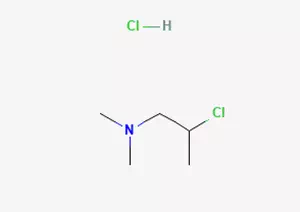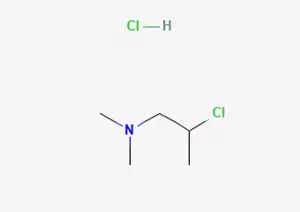All Categories


2-dimethylaminoisopropyl chloride hydrochloride CAS 4584-49-0, 2-dimethylaminoisopropyl chloride hydrochloride, CAS 4584-49-0
In the field of organic chemistry synthesis, there is an important compound preparation process, that is, 2-dimethylamino-2-propanol is chlorinated with thionyl chloride through a specific chemical reaction to obtain 2-dimethylamino-isopropyl chloride hydrochloride.
CAS : 4584-49-0
Formula : C5H13Cl2N
Mol. wt. : 158.07
EINECS : 224-971-7
Chemical Name | 2-Dimethylaminoisopropyl Chloride Hydrochloride |
Other Name | 2-(Dimethylamino)Isopropyl Chloride Hydrochloride; Isopropyl chloride; N,N-Dimethyl-2-chloropropylamine hydrochloride |
CAS | 4584-49-0 |
EINECS | 224-971-7 |
Type | Organic raw materials |
Molecular Formula | C5H13Cl2N |
Molecular Weight | 158.07 |

Melting point | 187-190 °C(lit.) |
storage temp. | Store below +30°C. |
solubility | 2000g/l |
form | Crystalline Powder |
color | White to light cream |
PH | 5-6 (500g/l, H2O, 20℃) |
Water Solubility | 2000 g/L (20 º C) |
Sensitive | Hygroscopic |
In the field of organic chemistry synthesis, there is an important compound preparation process, that is, 2-dimethylamino-2-propanol is chlorinated with thionyl chloride through a specific chemical reaction to obtain 2-dimethylamino-isopropyl chloride hydrochloride.
Specifically, under suitable reaction conditions, 1-dimethylamino-2-propanol was reacted with thionyl chloride. Through a series of complex chemical change processes, 2-dimethylamino-isopropyl chloride hydrochloride was finally successfully prepared. This compound has some remarkable characteristics in terms of chemical properties.
Among them, 2-dimethylaminoisopropyl chloride is incompatible with solid oxidants. This is because its chemical structure determines that when it encounters solid oxidants, it may undergo intense chemical reactions, thereby affecting the stability and safety of the substance.
From the perspective of chemical classification, amines belong to a type of chemical base. Amine compounds have unique chemical properties and can undergo neutralization reactions with acids. During the neutralization reaction, amines interact with acids to form corresponding salts and water. Moreover, these acid-base reactions are exothermic, which means that a certain amount of heat is released during the reaction process. It is worth noting that during the neutralization process, the heat released per mole of amine is largely not directly related to the toughness of the amine itself as a base.
In addition, amines may also be incompatible with many other substances. For instance, amines may react with isocyanates. When the two meet, a series of chemical changes may be triggered, leading to alterations in the properties of the substances. Amines and halogenated organic compounds may also be incompatible, and complex interactions may occur between them. Peroxides, phenols (acidic), epoxides, anhydrides and acyl halides and other substances may also react with amines, thereby affecting the stability and application effect of amines.
Under certain specific chemical reaction conditions, when amines combine with strong reducing substances (such as hydrides), flammable gas hydrogen is produced. This reaction not only alters the composition and properties of substances, but may also bring certain safety risks, as hydrogen is a flammable and explosive gas.
Regarding the flash point data of 2-dimethylaminoisopropyl chloride, there is no clear record at present. However, based on its chemical structure and related properties, it is speculated that 2-dimethylaminoisopropyl chloride may be flammable. This means that when storing, using and handling this compound, special attention should be paid to safety measures such as fire prevention and explosion prevention to prevent accidents.
In the field of drug synthesis, 2-chloro-N, N-dimethylpropylamine hydrochloride (DMIC), and 2-dimethylaminoisopropyl chloride hydrochloride are two important intermediates. They are respectively used in the synthesis of drugs such as isothiophene, methadone, promethazine, etc., as well as lipophilic chalcone analogues, central depressant drug Meisantong and antihistamine drug finagen, etc. These compounds play a significant role in the pharmaceutical industry and provide strong support for the treatment of various diseases.
However, it needs to be emphasized that the use of any chemical substances should be carried out within a strict legal and safety framework. When using these compounds, relevant laws, regulations and safety operation procedures must be followed to ensure the safety of personnel and the environment. At the same time, for intermediates involved in drug synthesis, quality control and supervision should also be strengthened to ensure the quality and safety of the final product.
In conclusion, these two compounds have broad application prospects in drug synthesis, but during the usage process, it is necessary to strictly abide by relevant laws, regulations and safety norms to ensure their reasonable, legal and safe use.
* Prompt reply and 24 hours online, professional team to provide best price and high quality product.
* Sample testing support.
* Every batch of products will be tested to ensureits quality.
*The packing also can be according the customers` requirment.
*Any inquiries will be replied within 24 hours.
*we provide Commerical Invoice, Packing List, Bill of loading, COA , Health certificate and Origin certificate. If your markets have any special requirements, let us know.